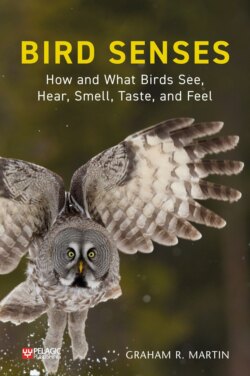Читать книгу Bird Senses - Graham R. Martin - Страница 25
На сайте Литреса книга снята с продажи.
Trade-offs between senses
ОглавлениеThe world of any one species is no more important or special than that of another. All sensory worlds have equal importance. They have been shaped by natural selection to extract information for the efficient conduct of the life of each species. For individual species there will be important constraints on how their sensory organs can perform. This is because there are costs and trade-offs in sensory capacities within a sense, and also between senses. The trading off of information between senses is something that will be discussed a number of times in this book. One particularly dramatic example is found in some ducks which, unlike most other birds, have comprehensive vision of the world about their head. This is only possible, however, because their foraging has become controlled by touch and taste information, so that they do not need to see where their bill is. This has resulted in a trade-off between vision, touch, and taste that has given rise to particular diets and behaviours.
An important constraint on how animals detect their environments comes from the metabolic costs of operating different sensory systems. Vision is particularly costly. Not only are eyes demanding of support and protection in the skull, but their actual running costs are high. There is a rapid and constant turnover of materials and large amounts of neural processing are necessary to extract information from visual input, and neural processing is demanding of energy. Eye size is a fundamental factor in both visual resolution (the amount of detail that can be extracted from a scene) and sensitivity (the minimum amount of light necessary for the extraction of information). As a general rule the larger the eye, the higher its sensitivity and resolution.
The eyes of most birds are small, but there are plenty of species that have large eyes – for example owls, albatrosses, raptors, hornbills, and penguins. In all of these species larger size would seem to be the result of natural selection for either high sensitivity or high resolution, or even both. But not all nocturnal species have large eyes. We might reasonably predict that large eyes could have easily evolved in kiwi species, because they are flightless and weight should not be a problem – but in fact the eyes of a kiwi are similar in size to those of a small passerine. The answer to this apparent paradox lies in the fact that kiwi conduct many tasks guided by information derived from non-visual senses, most notably smell, hearing and tactile cues from the bill tips. This is another striking example of how information from one sense can be traded off or complemented by information from another. In the case of kiwi, the result of these trade-offs is that their sensory world, their reality, is far removed from those of other nocturnal birds.
